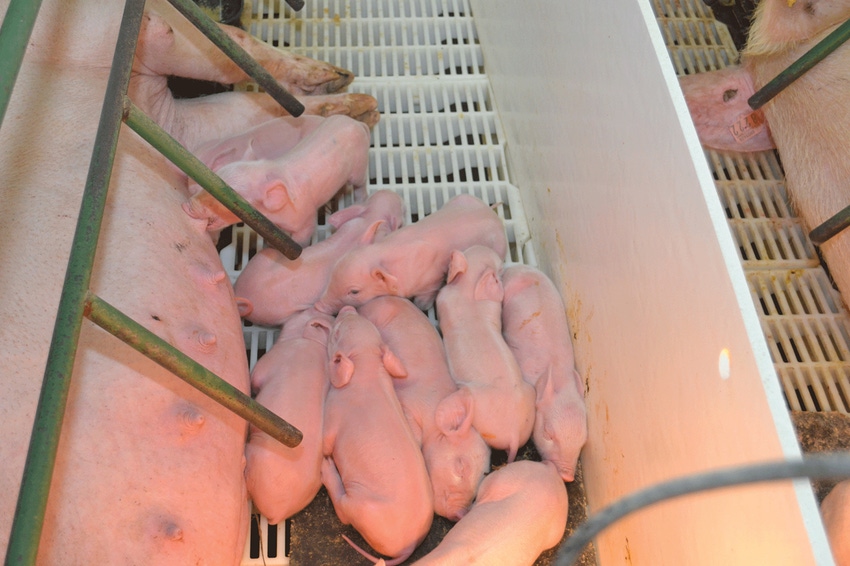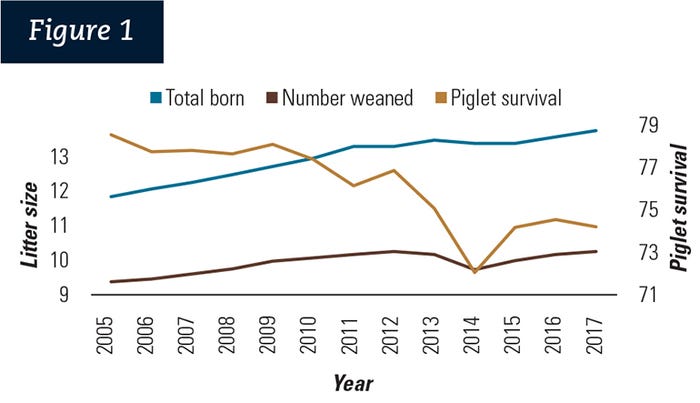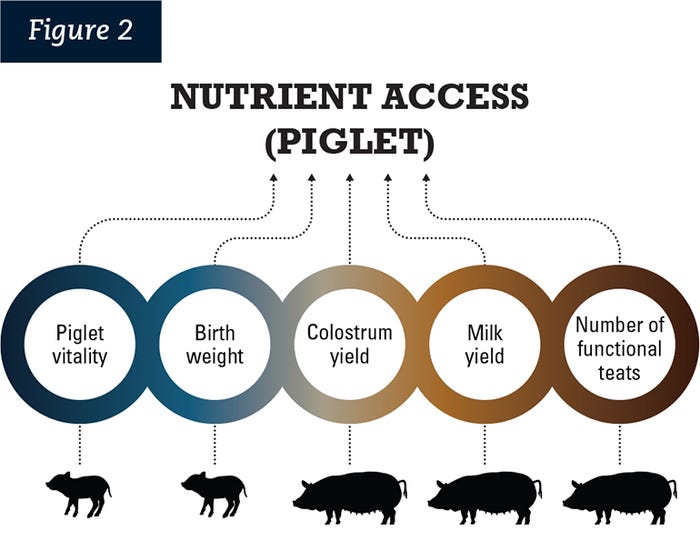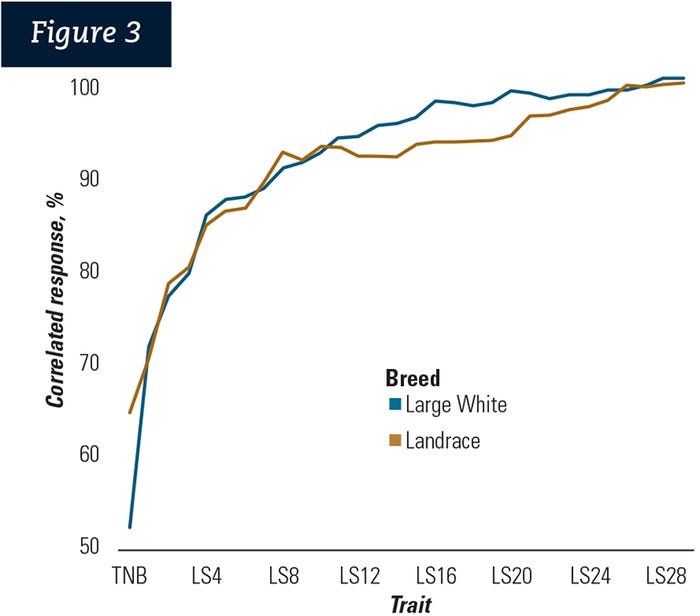Genetics of piglet throughput
Blueprint: Litter weaning weight would serve as the main "piglet quality" trait.
April 16, 2020

Throughput in relation to sow productivity can be defined as pounds of piglets weaned per sow. Using this definition, reproductive throughput would be a composite trait of number of piglets weaned and piglet weaning weight. Given pig producers are paid based on pounds marketed, weight weaned per sow appears to be a reasonable reproductive breeding objective for genetic suppliers.
Industry data show litter size in the United States has increased over the past 15 years, yet piglet survival has perhaps declined during that same time period (Figure 1). Until recently, many swine geneticists sought to enhance reproductive throughput by increasing total number born or number born alive with little or no emphasis placed on piglet weight traits. This has arguably caused an erosion in piglet quality. Research shows increasing litter size at birth reduces average piglet birth weight. Greater piglet birth weight is associated with increased piglet survival, increased survival post-weaning, greater lifetime growth rate and improved feed conversion. Increasing litter size also reduces colostrum intake per piglet as the sow does not magically make more colostrum if she farrows a larger litter.

Past studies show increased piglet colostrum intake enhances piglet survival, post-weaning survival and lifetime growth rate. Hence, in order to maximize piglet throughput, strategies are needed to overcome industry trends in piglet survival and piglet quality.
Piglet nutrient access
Perhaps piglet nutrient access largely explains the variation in piglet survival and piglet quality. Piglet nutrient access is impacted by piglet birth weight, piglet vitality, a sow's number of functional teats, sow colostrum yield and sow milk yield (Figure 2). Low birth weight piglets may not be physically large enough to suckle or have difficulty nursing. Low vitality piglets, often impaired by hypoxia, may also have challenges consuming enough colostrum to survive. The importance of sow functional teat count on piglet survival has clearly been demonstrated recently and decades earlier. Both sow colostrum yield and milk yield impact piglet survival and influence piglet weaning weights. Hence, a selection strategy focused on improving reproductive throughput should include traits that enhance piglet nutrient access.

Enhancing piglet quality
How can piglet quality be improved using genetics? As the saying goes, what is old is new again. Over 25 years ago, Neal and Irvin (1992) showed us how to improve piglet quality and litter size simultaneously by selecting for sow productivity index (SPI equals 6.5 multiplied by number born alive plus adjusted 21-day litter weight). After 10 generations of selection, the authors reported improvements in both litter size and piglet weaning weights. Improvements in SPI coincided with increases in number of fully formed fetuses, fetal survival and uterine weight. However, SPI did not impact ovulation rate. Therefore Neal and Irvin noted continued improvement in litter size, when selecting for SPI, may be limited by ovulation rate. Nonetheless, Neal and Irvin provided us a blueprint to work from on how to improve piglet throughput.
Neal and Irvin's work is supported by a recent study from Kennedy (2017). Through a partnership with Smithfield Premium Genetics, Kennedy estimated genetic parameters for a trait termed "number of quality weaned piglets." Number of quality weaned piglets is a similar trait to number weaned, yet only included piglets if they weighed 7 pounds or more at weaning. In other words, number of quality weaned piglets is number weaned excluding runt piglets. Results showed genetic correlations between number of quality weaned piglets with litter weaning weight were 0.89 and 0.95, respectively, for Landrace and Large White breeds. A genetic correlation of 0.90 or greater indicates two traits are the same or nearly the same. Hence, number of quality weaned piglets and litter weaning weight were nearly the same trait. In the same study, genetic correlations between number of quality weaned piglets with number born alive were 0.63 and 0.63, respectively, for Landrace and Large White breeds. Taken together, these genetic associations suggest improvements in both litter weaning weights and litter size are needed to maximize the number of quality weaned piglets.
Piglet quality has received increased attention from U.S. geneticists the past several years. Breeding objectives for many genetic suppliers have been tweaked to put more emphasis on improving piglet quality. Yet I am not certain they are incorporating the correct traits to maximize piglet throughput. Recent emphasis has been placed on improving piglet birth weights. Greater piglet birth weights generally coincide with increased piglet vigor, enhanced colostrum harvest and better thermoregulation relative to smaller piglets. All good things. Yet if a sow has poor colostrum yield or milk yield, piglet birth weight may not matter. A heavy birth weight piglet cannot consume colostrum or milk unless the sow is able to produce it. Perhaps the most valuable piglet quality trait is litter weaning weight. Heavier litter weaning weights are associated with larger piglet birth weights, greater piglet vitality, additional functional teats, enhanced sow colostrum yield and increased sow milk yield. Hence, heavier litter weaning weights are very much connected to improving piglet nutrient access.
Importance of functional teats
How essential are the number of functional teats on a sow to piglet throughput? The answer, perhaps, depends. As litter size continues to increase, production systems could utilize more nurse sows to ensure every piglet has adequate teat access. Yet I suspect in the United States we will add at least a few more functional teats to our sows in the near future. The importance of functional teats has been known for more than 50 years. Enfield and Rempel (1961) reported an increase in one functional teat improved the number weaned by 0.27 piglets per litter.
More recently, in a collaboration with Smithfield Premium Genetics, Earnhardt (2019) also reported an additional functional teat improved the number weaned by 0.27 piglets. Other recent reports by Wiegert (2019) and Obermier (unpublished) showed an increase in one functional teat improved litter size at weaning by 0.31 and 0.32 piglets, respectively. Taken together, these results suggest an additional functional teat on your sow herd would enhance piglet throughput by 2 to 3%.
This past fall we have started a research genetic selection line for number of functional teats at our North Carolina Department of Agriculture Tidewater Research Station. We plan to explore the upper biological limit, work on classifying functional teats at an early age and identifying any potential problems with selection for number of functional teats.
Selection for litter size
Can efficiency of selection for litter size be improved? Most piglet deaths occur within the first several days of birth. Therefore, geneticists in Denmark started selecting for number of piglets alive at Day 5 in lactation. This means piglets that do not survive between birth and Day 5 of lactation would be discounted. The Danes showed selecting for litter size at Day 5 versus litter size at birth continued to enhance litter size yet slowed the decline in piglet survival. Building upon the work of the Danish geneticists, Putz et al. (2015) collaborated with Smithfield Premium Genetics to identify alternative litter size traits in swine. Putz's objective was to identify the best time in lactation to measure litter size in order to maximize genetic improvement for piglets weaned. Results from the study are shown in Figure 3. Efficiency of selection for litter size was relatively low the first several days of lactation and then plateaued near 90% to 95% the second and third weeks of lactation. Collectively, these results suggest improvement in reproductive throughput would be reduced when selecting for total number born or number born alive when compared to litter size measured later in lactation. Therefore geneticists should focus on litter size traits quantified later in lactation to help mitigate piglet mortality and maximize piglet throughput.

Maximizing piglet throughput
How should geneticists maximize piglet throughput? Perhaps by tweaking the equation from Neal and Irvin by including the traits litter weaning weight, number of functional teats and litter size at weaning (of the biological dam). Litter weaning weight encompasses components of birth weight, vitality, colostrum and milk production. Therefore litter weaning weight would serve as the main "piglet quality" trait. Including number of functional teats helps enhance litter size at weaning by improving piglet survival. Genetic nucleus herds generally cross-foster piglets at birth. Cross-fostering at the nucleus level has perhaps helped hide the importance of function teat count from geneticists. Enhancing litter size at weaning is the last piece to improving piglet throughput. Although measuring litter size at Day 5 or later in lactation may also be acceptable. Moving away from selection on total number born and number born alive will help mitigate piglet mortality.
Going forward
In the future it will be important for geneticists to understand genetic associations between piglet quality traits and post-weaning mortality. Research has shown phenotypic correlations between piglet birth weight and weaning weight with post-weaning mortality. Yet genetic associations need to be evaluated. If favorable, genetic improvement for piglet quality would increase in importance.
Knauer is a North Carolina State University associate professor and Extension swine specialist. Questions can be sent to him. He would also like to acknowledge Smithfield Premium Genetics for its continued partnership with NCSU.
References
Earnhardt, E. 2019. The genetics of functional teats in swine. MS Thesis, North Carolina State Univ., Raleigh.
Kennedy, E. 2017. Estimates of variance components for genetic correlations among swine litter quality traits. MS Thesis, North Carolina State Univ., Raleigh.
Knauer, M.T., C.E. Hostetler. 2013. U.S. swine industry productivity analysis, 2005-10. J. Swine Health Prod. 21:248-252.
Putz, A.M., F. Tiezzi, C. Maltecca, K.A. Gray and M.T. Knauer. 2015. Variance component estimates for alternative litter size traits in swine. J. Anim. Sci. 93:5153-5163.
Stalder, K.J. 2018. 2017 Pork industry productivity analysis. National Pork Board Report.
Wiegert, J. 2019. Effects of practically increasing amino acids and energy in late gestation on colostrum intake, colostrum composition and sow performance. PhD dissertation, North Carolina State Univ., Raleigh.
You May Also Like



